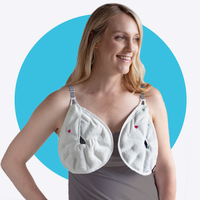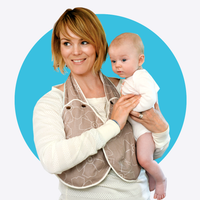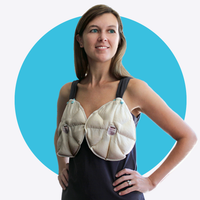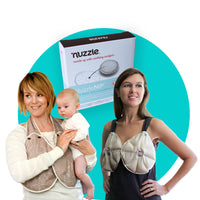Back-to-work Tips for Breastfeeding Mamas

Going back to work post baby is a big adjustment. Let’s be honest, it can be a mental and physical roller coaster. With a little prep and planning, it doesn’t have to be as jarring. Having a flexible plan with preparedness is key. We’ve got 6 tips to make your back-to-work transition a little less bumpy for the whole family.
Know your rights and protections (or lack thereof)
Understanding policies and your rights as a new parent will help you navigate with knowledge; maybe even nudge folks to take action to change the US maternity laws toward a more equitable scenario for American families. The reality is, when it comes to the U.S., we have fewer maternity leave protections and benefits than any other developed, high-income country. Period. (More on that in a bit if you’re interested in the legalities.)
Talk to your employer BEFORE your maternity leave. Ask your HR and/or management department about the company’s policy for a nursing mother’s break time. Let your coworkers know you’ll be blocking out routine and undisturbed breaks in your schedule and that you may need some flexibility. Let your employer know you will need (and required by law) a private space.
If you are planning on using a corded breast pump (or non-rechargeable) make sure the space has access to an electrical outlet and note if an electrical cord extension may be required.
Requesting a small refrigerator to store your pumped breastmilk would be ideal, but not always possible. If you don’t have access to a refrigerator, be sure to bring ice packs to store your milk and keep that liquid gold fresh. A tip to keep in mind is that freshly expressed or pumped milk can be stored at room temperature (77°F or colder) for up to 4 hours.
(Jump ahead to Tip 2 if you’d like to bypass the soapbox of the gloomy maternity legalities.)
The United States FMLA, Family Medical Leave Act, only entitles parents who work at public agencies, public and private schools, and companies with 50 or more employees, twelve worksweeks of unpaid maternity leave. That’s two weeks less than the 14-week standard set by the ILO, International Labor Organization. To put this into perspective, the US is at the bottom of the barrel when it comes to time off for new families. Bulgaria rakes the highest at 58.6 weeks followed by Greece at 43 weeks. The UK offers 39 and New Zeland, 22, Canada lands between 15 to 17 weeks, just to set come context.
If that doesn’t crack your nipple, notably lacking further, the United States is the only industrialized country in the world that doesn’t have paid family leave. Over 120 nations across the globe provide paid maternity leave for growing families: the US in NOT one of them. That’s correct, the federal government offers zero, zilch, nada, paid maternity, however, as of April 2022, 10 states have created their own plans to offer paid maternity leave (see state by state detail). Lack of financial support from our federal government puts a tremendous amount of stress on families. Mothers are faced with the tough choice of providing financial income by going back to work which requires resourcing childcare, or to provide financially by staying at home with baby. It can be an overwhelming and uncertain decision. It’s no wonder, why we have so much anxiety, about joining the workforce after 12 short weeks (or less) from welcoming your tiny citizen into this world.
Regarding breastfeeding, section 7 of the Fair Labor Standards Act was amended in 2010 to require employers (that meet certain requirements) to provide reasonable breaktime for nursing mothers. Non-exempt employers must not only provide time, but a space that is not a restroom, that is shielded from view, and free from intrusion (so locked) to pump milk. This federal law cannot be undermined by state laws, meaning your state can add added protections, but they cannot do less than the federal law mandates. When going back to work, it’s important to know if you qualify under the federal law or if your state has added protections. A great place to start is your state coalition.
Ease into it and go easy on yourself
If it’s possible, try to return mid-week or start with half days. This allows you to ease back into work/school life. If you have sleepless nights from night feedings, the new daytime work schedule will feel heavy on your eyelids and heavy on your heart. Lean on your support system because it does take a village. See if you can get support to provide meals for your first week or two or plan to pick up food. How about transportation? Can someone help with pick-up and drop-off if you have a distance from childcare? Driving with a newborn in tow is a whole different level stress. Any time that you can free up to spend more time with baby, or more time for yourself to relax and focus on mama’s wellbeing, the better off the whole family will be.
Prepare your space to prep your mindset
Your goal is to try to set the mood of relaxation and make the environment as comfortable as possible. When you are pumping at work, you’re out of your comfort zone. When you’re out of your comfort zone, it’s difficult to relax. If you’re not relaxed, it can be stressful to pump. If your stressed, your love hormone, oxytocin, is reluctant to show up for the milk party. Your prolactin, the hormone that helps you express milk, is triggered by its BFF, oxytocin. So, you can see where this is going; being relaxed, soothed, and stimulated by baby helps you lactate. Baby’s tender touch, that newborn smell, the sound of bubbly giggles and even cries, all contribute to helping your body with milk production.
Some moms may start having a letdown mid-meeting and are desperate to dash off and pump. Others might require more stimulation, especially when baby in not nearby. It’s helpful to have photos of your tiny human in the environment or to have your hands free to scroll through the zillion adorable photos and videos on your phone. You can also bring one of your baby’s used blankets or onesies for that new baby smell.
The application of warm therapy can also help with relaxation, and when applied to the breasts, can help stimulate let-down and help with milk flow. Nuzzle offers warming therapy solutions are easy to use and can be worn over your clothes in a hands-free fashion. If you are looking for a fuller body experience, the NuzzleHUG provides a combo of breast and neck therapy that will put you in instant relaxation mode. The NuzzlePUMP Pods are another cozy option that work with traditional breast pumps.
Prepare your tools
If you haven’t ordered your breast pump, the period immediately postpartum would be a great time to do so. Many parents invest in a pump bag (if their pump doesn’t come with one) to carry items back and forth to work or school. Hopefully you’ll know ahead of time if the space has access to an electrical outlet if you plan on using a corded breast pump and if an electrical cord may be required. Ensure you purchase any accessory or extra parts you may need. Some items you can keep in your bag are:
- Breast pump, charger, and/or electrical cord if needed
- Flanges
- Milk collection bottles
- Milk storage bags
- Breast pump holster or holder if using a traditional style breast pump
- Mini cooler with ice packs if a refrigerator is not accessible
- Absorbent breast pads, or a milk catcher for leaky boobs
- Thermal breast therapy
- Nursing shawl if your worried about anyone accidently popping in on you
- Photos of baby
- Water bottle for you to stay hydrated
- Bottle brush
- Dishwashing liquid
- Small absorbent towel for any clean ups
- An eye mask of you can sneak in a wink or two while pumping, oh it can happen!
Prepare your supply
Nursing or pumping (exclusively pumping) frequently and consistently (8-12 times a day) sets the foundation for a solid milk supply. No matter how much maternity leave you take, establishing good habits is key. Babies who consume human milk only need 1-1.5oz per hour (so 3-4.5oz if they eat every 3 hours), so to return to work, for an eight hour work day, you would only need approximately 9-12 ounces. The exact amount will depend on baby’s last feed before drop off, how many hours you work, baby’s intake, and your commute time.
To prepare to return to work, begin pumping 1-2 weeks, one to two times a day, before your scheduled return. You can sneak a pump session in after your first feeding of the day (as your prolactin starts to decrease) or in the evening, at the start of baby’s longest sleep stretch.
Prepare your baby
Introducing a bottle can be very stressful for new parents. What’s the best brand? Will my baby take this bottle? Will introducing a bottle affect how my baby nurses? Let’s go through some of these, shall we? There’s really no best brand as much as there is ideal shape. You want a bottle nipple that gradually widens so that it encourages a deep latch, just like you’d want at the breast. IBCLC bottle feeding queen Rachel O’Brien goes more in depth here. Once you find that nipple that encourages that nice, deep latch, you want to try using it with baby. You can do this with the bottle top detached (like a pacifier) or offering baby expressed milk (you can offer a full feeding or just a few ounces) once you begin pumping. If your baby is struggling with taking a bottle, it’s best to reach out to a lactation professional so that you get help and assistance early.






